This season’s rookie class has the potential to be among the best in recent memory.
Almost every team has at least one notable rookie to watch and some have a few contenders for the Calder Trophy, awarded to the NHL’s top rookie.
For the fifth year in a row — dating back to 2015, with Connor McDavid and Jack Eichel — the first two picks from this year’s draft are among the betting favourites. They will be challenged by several top-10 selections and first-rounders from previous drafts, plus some late-bloomers and older Europeans that could emerge as sleepers.
With the puck dropping tomorrow, here is a closer look at the Calder candidates — counting down from No. 31 to No. 1, followed by 50 honourable mentions.
31) Dillon Dube, Calgary Flames
PROJECTED ROLE: AHL call-up
ANALYSIS: Dube, a second-rounder from 2016, is one of the more experienced rookies — having already played 25 games, one short of the cutoff for Calder eligibility — but he’ll be starting this season in the AHL after a mediocre training camp in Calgary. Dube should continue to dominate at that level — he was over a point per game in the AHL last season as a rookie pro — so expect him to be the first call-up for the Flames whenever a forward is hurt. Once that door opens, Dube could kick it down and stay in the NHL for good while making his case for the Calder. This demotion should serve as added motivation.
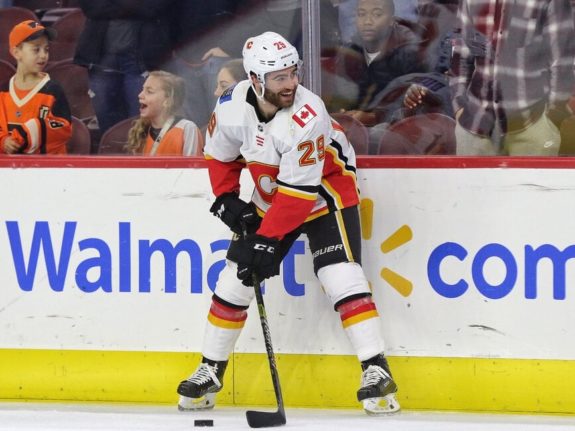
30) Morgan Frost, Philadelphia Flyers
PROJECTED ROLE: AHL call-up
ANALYSIS: Frost, the 27th overall pick from 2017, may have started in the NHL if he was healthy since Nolan Patrick is currently sidelined, but a groin injury took him out of contention to crack the Flyers’ opening-night roster. As a result, Frost will need to fully recover and get back up to speed in the AHL. If Patrick’s migraine issue persists, Frost might still get that chance to centre Philadelphia’s third line sooner than later. Frost is an offensive catalyst coming off two straight 100-point campaigns in the OHL, so he could put up decent numbers if he gets the call-up soon enough, which could get him into the Calder conversation.
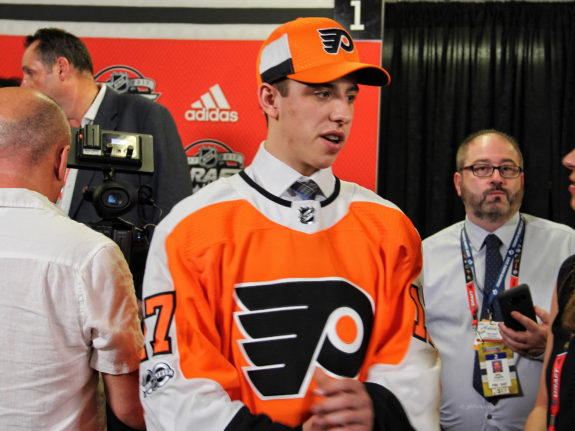
29) Filip Zadina, Detroit Red Wings
PROJECTED ROLE: AHL call-up
ANALYSIS: Zadina, the sixth overall pick from 2018, failed to score in the preseason and now finds himself back in the AHL for more seasoning. Detroit has always been patient with their prospect development, so Zadina’s demotion shouldn’t come as a major shock, but it’s still a little disappointing since many expected him to stick with the rebuilding Red Wings and contend for the Calder this season. Starting out in the minors, Zadina can be labelled a long-shot, but he’s a scorer — a pure sniper — so if he starts filling the net in the AHL, that recall could still come in the early stages.
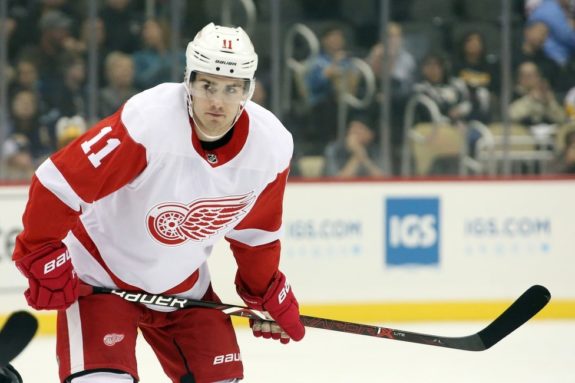
28) Vitali Kravtsov, New York Rangers
PROJECTED ROLE: AHL call-up
ANALYSIS: Kravtsov, the ninth overall pick from 2018, is adjusting to life and hockey in North America, with the talented Russian teenager getting acclimatized in the AHL. He was sent down along with Filip Chytil and they should form a dynamic duo at that level. Kravtsov will turn 20 in December and there is a decent chance he’ll be in the NHL by then, providing those two rip it up together in Hartford. The Rangers would welcome an offensive boost from Kravtsov once he’s more comfortable and confident on the smaller ice. Kravtsov will be playing catch-up in the Calder race, but don’t count him out before he gets going.
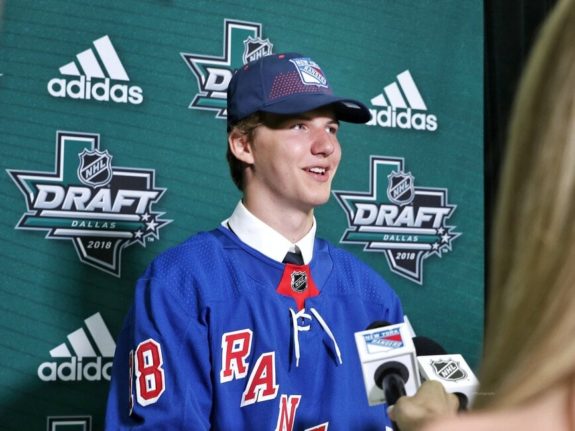
27) Oliver Wahlstrom, New York Islanders
PROJECTED ROLE: AHL call-up
ANALYSIS: Wahlstrom, the 11th overall pick from 2018, was one of the final cuts for the Islanders, with Lou Lamoriello suggesting he was close to being NHL ready despite only playing a total of 10 AHL games after turning pro towards the end of last season. Wahlstrom made a positive impression during his first NHL training camp and could be called up from Bridgeport as soon as an offensive forward goes down to injury. If the Islanders are struggling to score and Wahlstrom is producing in the AHL, they might have to make room for him sooner than later even if everyone stays healthy. The sooner that call comes, the better his chances at the Calder.
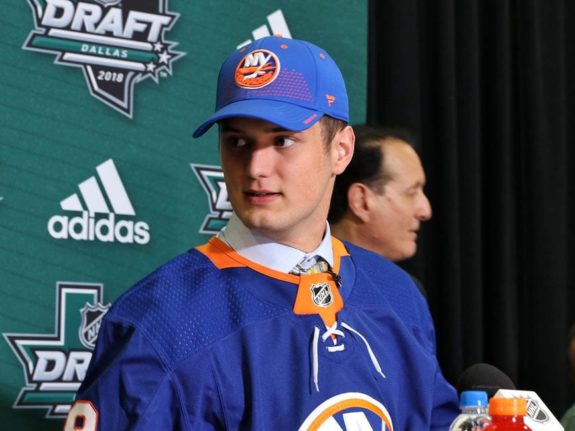
26) Thatcher Demko, Vancouver Canucks
PROJECTED ROLE: 2G
ANALYSIS: Demko, a second-rounder from 2014, enters his first full NHL season as Vancouver’s backup behind Jacob Markstrom. Demko posted an impressive .913 save percentage over nine appearances last season, but Markstrom is still the No. 1 there and Demko probably won’t get enough starts to be taken seriously for the Calder. That is, unless Markstrom were to get hurt. Markstrom is entering a contract year as a pending free agent next summer, but it’s unlikely he’ll be traded with the Canucks hoping to compete for a playoff berth this season. Demko turns 24 in December and many see him as Vancouver’s goaltender of the future, but he’ll need some luck in the present — or bad luck for Markstrom — in order to get the workload necessary for Calder consideration. Demko would likely need upwards of 40 appearances while backstopping the Canucks to the postseason.
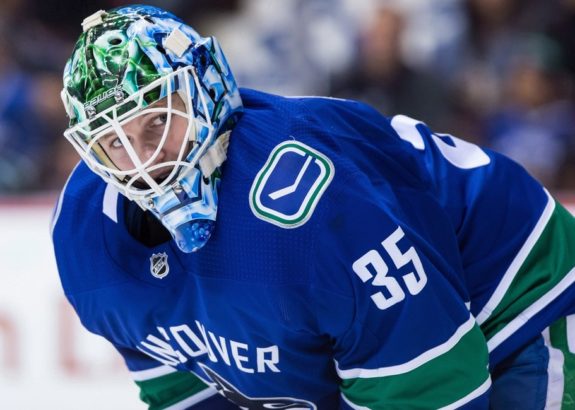
25) Dante Fabbro, Nashville Predators
PROJECTED ROLE: 2RD
ANALYSIS: Fabbro, the 17th overall pick from 2016, isn’t overly flashy and may not be that offensive as a pro, but he’s an effective defender and will be debuting in a fairly prominent role. It’s unlikely he’ll get much power-play time in Nashville, so Fabbro probably won’t produce the stats required of a defenceman to win the Calder. Stats are crucial when it comes to Calder voting, but that doesn’t mean Fabbro won’t be one of the league’s better rookie blueliners this season.
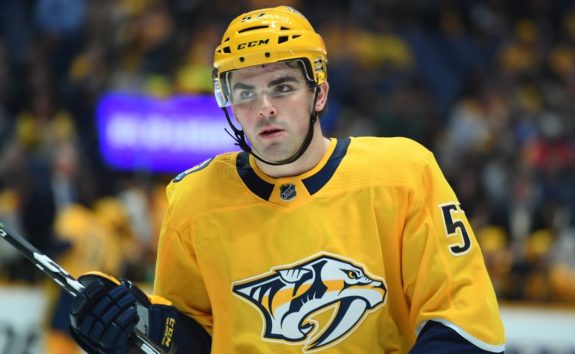
24) Jesper Boqvist, New Jersey Devils
PROJECTED ROLE: 3LW
ANALYSIS: Boqvist, a second-rounder from 2017, could be the second Jesper from Sweden to surprise the masses as a member of the Devils. The first was Jesper Bratt two years ago — as a sixth-rounder — and Boqvist could have a similar impact as an unheralded rookie. Boqvist will be flying under the radar with a handful of higher-profile newcomers in New Jersey, but he’s skilled enough to enjoy a productive debut in North America and possibly even enter the Calder conversation in the process.
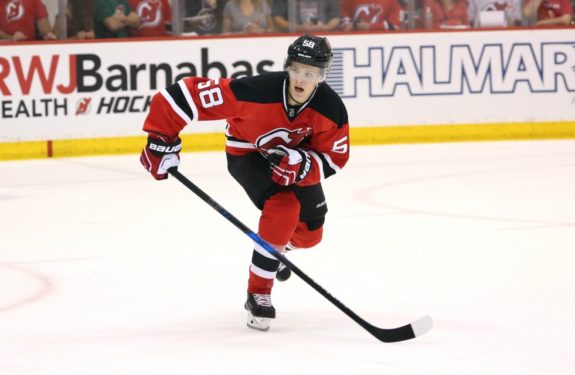
23) Emil Bemstrom, Columbus Blue Jackets
PROJECTED ROLE: 4RW, PP
ANALYSIS: Bemstrom, a fourth-rounder from 2017, led Sweden’s pro league in goals last season — lighting the lamp 23 times. The Blue Jackets will need all the goals they can get this season, so they will likely find a role for Bemstrom, which could include being a triggerman on their top power-play unit. He’ll need to contribute at even strength — at both ends of the ice — to stay in John Tortorella’s good books, but Bemstrom could work his way up the depth chart and perhaps score enough to become a dark horse for the Calder.
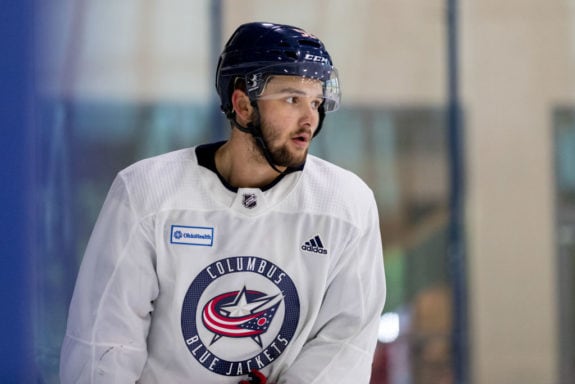
22) Dominik Kubalik, Chicago Blackhawks
PROJECTED ROLE: 3RW
ANALYSIS: Kubalik, a seventh-rounder for Los Angeles back in 2013, has finally made his way overseas at the age of 24. Chicago has had plenty of success with older Euros — Dominik Kahun just last season and obviously Artemi Panarin — so the Blackhawks could be unearthing another gem in Kubalik. He’s got a wicked release — certainly an NHL-calibre shot — and is coming off a 25-goal campaign in Switzerland. Kubalik is still a foreign name to casual hockey fans, so he can be labelled a sleeper for the Calder.
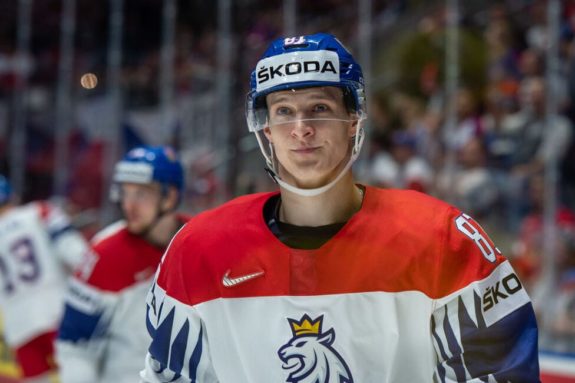
21) Taro Hirose, Detroit Red Wings
PROJECTED ROLE: 2RW
ANALYSIS: Hirose, an undrafted free agent signed out of college, surprisingly put up seven points — albeit only one goal — in his 10-game stint with Detroit to end last season. That gave him a leg up and a confidence boost coming into training camp, with Hirose outperforming some of the Red Wings’ top forward prospects through the preseason — making the cut over top-10 picks Filip Zadina and Michael Rasmussen. Hirose is an overachiever but appears to be a legitimate talent. He’s 23 years old and isn’t the first name that comes to mind when thinking about the Calder, but Hirose continues to exceed expectations. He could become the next Jonathan Marchessault or Yanni Gourde. They were both undrafted and are about the same size too.
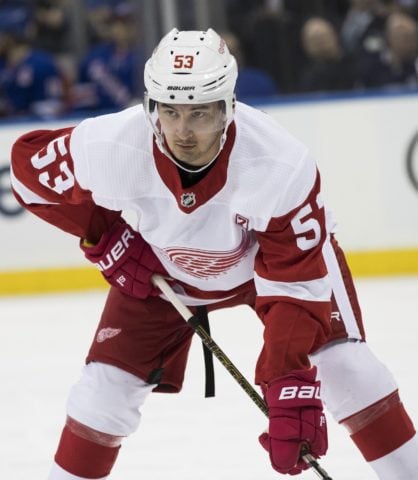
20) Kirby Dach, Chicago Blackhawks
PROJECTED ROLE: TBD
ANALYSIS: Dach, the third overall pick in this year’s draft, has been sidelined by a concussion sustained in the Traverse City rookie tournament, but he’s nearing a return and the Blackhawks were high enough on him to keep Dach in the fold for their Euro trip to start the season. He probably won’t play in Friday’s opener from Prague but could make his NHL debut upon getting back to Chicago, providing his symptoms don’t resurface. Looking at Chicago’s depth chart, Dach would look good between Brandon Saad and Dominik Kubalik on the third line, bumping David Kampf down to the fourth line with Drake Caggiula and Brendan Perlini. That would allow the Blackhawks to roll four scoring lines and become one of the Western Conference’s deeper teams up front. But it will be one game at a time for Dach and the odds are still in favour of him getting returned to junior at some point, which would take him out of the running for the Calder.
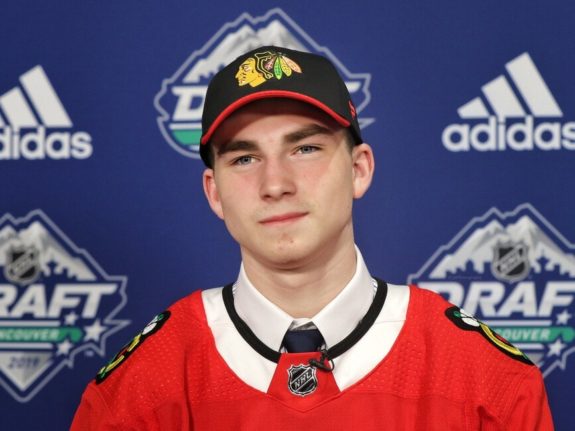
19) Noah Dobson, New York Islanders
PROJECTED ROLE: 3RD
ANALYSIS: Dobson, the 12th overall pick from 2018, has made the Islanders to start the season and might stick beyond the nine-game audition. He is one of those prospects that should be an exception to the 19-year-old rule since he has nothing left to prove in junior. However, it’s NHL or back to the QMJHL for Dobson, with the AHL not an option due to his age and the CHL agreement that will be revisited for the next CBA. That might make the Islanders more inclined to keep Dobson in the big league if he’s staying afloat through those first nine games. The 40-game deadline could be decision time on Dobson, but he’s got some game-breaking abilities as a defenceman that the Islanders have been lacking. If those abilities are translating to points and earning him power-play time, Dobson could become a go-to guy ahead of schedule and could also become a Calder contender if he plays the full campaign.
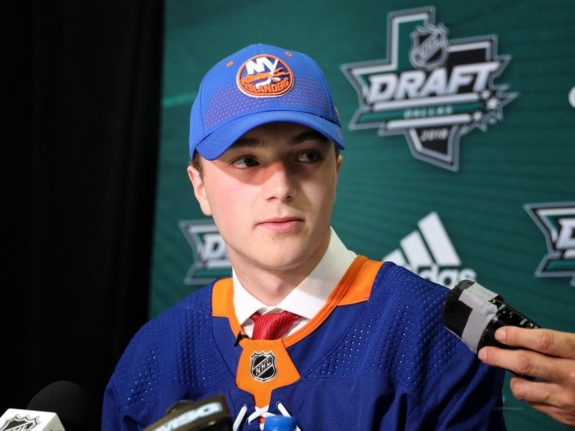
18) Barrett Hayton, Arizona Coyotes
PROJECTED ROLE: TBD
ANALYSIS: Hayton, the fifth overall pick from 2018, is in the same boat as Noah Dobson in that he’ll need to go back to junior — to the OHL — if he doesn’t earn a permanent role in the NHL. Arizona is pretty deep up front without Hayton, but Rick Tocchet will likely work him into some regular-season games to see where and how he might fit into the Coyotes’ puzzle once the pace picks up from the preseason. Hayton has the size and two-way skills to play up and down the lineup and to be a reliable forward as a teenager. The question is whether he could produce enough offence to push for the Calder — and also what’s best for his development?
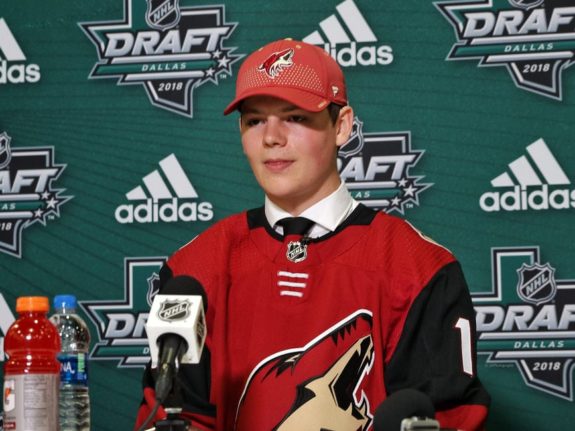
17) Max Comtois, Anaheim Ducks
PROJECTED ROLE: 3LW
ANALYSIS: Comtois, a second-rounder from 2017, is going to carve out a role in Anaheim this season. That could range from a checking role to more of an offensive role. He’s 20 now, so he can be sent down to AHL San Diego if he’s struggling to hold his own, but Comtois can make an impact in several ways, including as a physical presence. Comtois isn’t a finesse player, he’ll go to the net and gladly take the ugly goals — and if he gets enough of them, it could add up to becoming a Calder nominee.
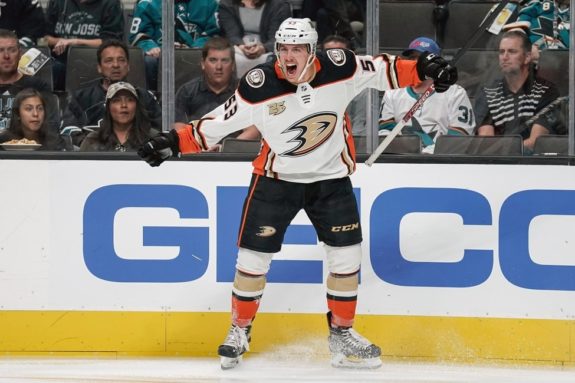
16) Ryan Poehling, Montreal Canadiens
PROJECTED ROLE: TBD
ANALYSIS: Poehling, the 25th overall pick from 2017, debuted with a hat trick and a shootout winner in last season’s finale, which raised the bar on expectations for him this season. Poehling was dealing with a concussion during the preseason and it’s tough to tell where he’ll fit into Montreal’s depth chart unless the Canadiens roll four scoring lines. They have enough offensive talent to do so, but they also have some checking types on the roster with Nate Thompson and Nick Cousins. Will Claude Julien play Poehling ahead of those two or would he be better served in a first-line role with AHL Laval? Four scoring lines is the way of the future and it’s possible that Poehling could be productive enough — even on the fourth line with the likes of Jordan Weal and Paul Byron — to challenge for the Calder.
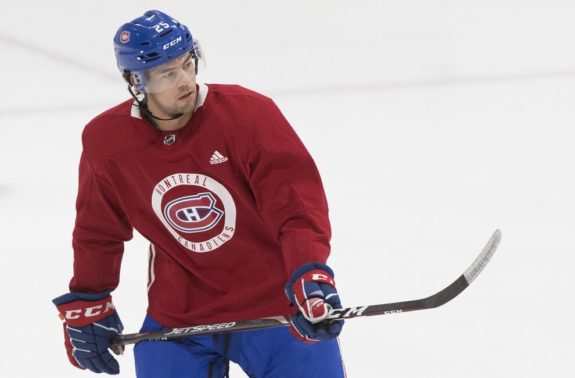
15) Drake Batherson, Ottawa Senators
PROJECTED ROLE: 3RW
ANALYSIS: Batherson, a fourth-rounder from 2017, didn’t have the best preseason and is starting outside of Ottawa’s top six as a result, but there is a good chance he’ll be playing a significant role as the regular season progresses, with the Senators likely selling off some of their veteran forwards. Batherson has all the tools to be a successful NHLer — perhaps the second coming of Mark Stone — and if he takes another step this season, Batherson could play his way into the Calder mix.
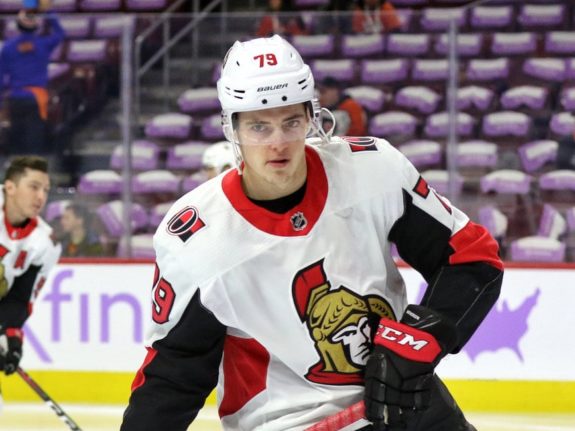
14) Sam Steel, Anaheim Ducks
PROJECTED ROLE: 2C
ANALYSIS: Steel, the 30th overall pick from 2016, has been sidelined by a lower-body injury, but he’s still pencilled in as Anaheim’s second-line centre this season. That will mean playing between quality wingers once he’s healthy — potentially Rickard Rakell and Jakob Silfverberg or Ondrej Kase — so Steel is going to be in a prime position to take a run at the Calder. He is a playmaker, so having shooters on either side will be beneficial for Steel. He got into 22 games with Anaheim as a rookie pro last season while also starring for Dallas Eakins with AHL San Diego, so that familiarity and experience will help Steel settle in at the NHL level this time around. He’s not the biggest name in the Calder race — nor the biggest or fastest player in general — but Steel has produced at every level and could really soar with the Ducks.
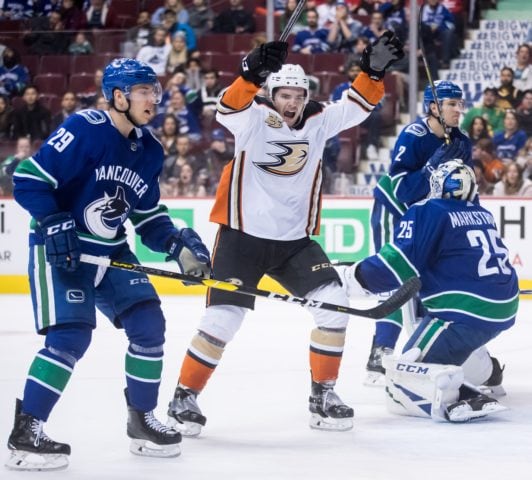
13) Alexandre Texier, Columbus Blue Jackets
PROJECTED ROLE: 1LW
ANALYSIS: Texier, a second-round pick from 2017 who hails from France, is benefitting from the mass exodus in Columbus. The 20-year-old rookie is slotting into the hole left by Artemi Panarin. That is still a huge hole, but Texier was impressive upon arriving in North America to end last season, producing at a point-per-game pace in the AHL before chipping in at the NHL level in a depth role while not looking the least bit intimidated in the playoffs. Now he’s in a starring role — alongside Pierre-Luc Dubois and Cam Atkinson on the top line — but it’s best to temper the expectations on Texier. His offensive upside is still to be determined, but his prime placement makes Texier something of a Calder candidate.
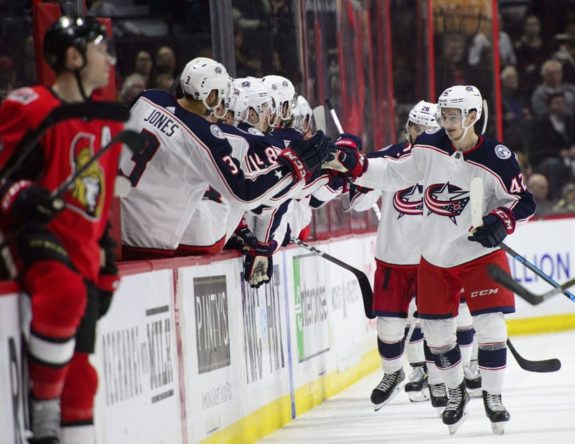
12) Erik Brannstrom, Ottawa Senators
PROJECTED ROLE: 2LD, PP
ANALYSIS: Brannstrom, the 15th overall pick from 2017 and the key return from the Mark Stone trade, came on strong as the preseason progressed and earned his spot on the opening-night roster. He’ll be paired with veteran Ron Hainsey, which should allow Brannstrom to play to his strengths. He’s an offensive-minded defenceman, though not as explosive as Thomas Chabot. They are much different players, but Brannstrom should put up his share of points — perhaps enough to warrant Calder consideration.
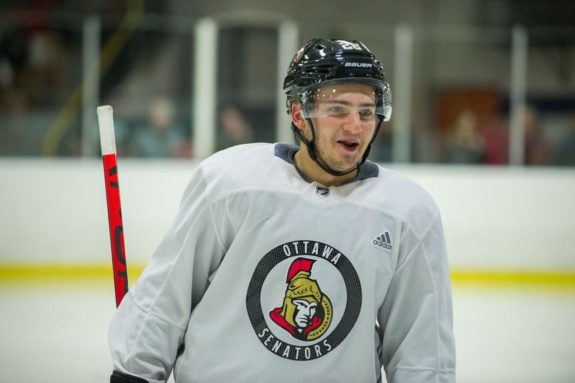
11) Martin Necas, Carolina Hurricanes
PROJECTED ROLE: 3RW
ANALYSIS: Necas, the 12th overall pick from 2017, didn’t have the best preseason but will be getting a little extra leash to establish himself as an NHLer this year. That benefit of the doubt is based on his draft pedigree and past accomplishments, including a promising North American debut in the AHL last season. A natural centre, Necas will likely be starting on the wing alongside Erik Haula. The Hurricanes will be rolling three scoring lines, so Necas should still have a chance to shine in offensive situations. He’s more of a playmaker and possesses a high hockey IQ, so Necas should eventually take off in pursuit of the Calder.
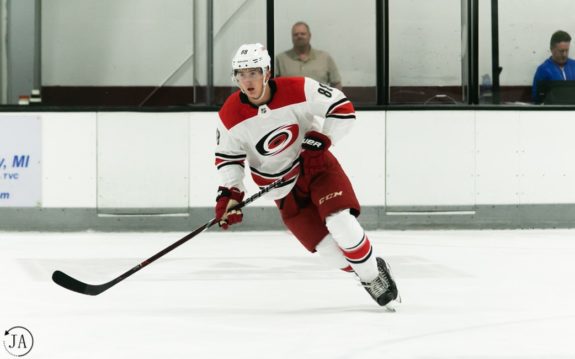
10) Joel Farabee, Philadelphia Flyers
PROJECTED ROLE: 3RW
ANALYSIS: Farabee, the 14th overall pick from 2018, had a strong start to camp while filling in for Travis Konecny and continued to prove capable when bumped down the lineup. Farabee will likely be paired with Nolan Patrick once he’s healthy and they could form a potent third line for Philadelphia. Farabee could also move back up if and when injuries arise, so he might get enough opportunity to get into the Calder mix.
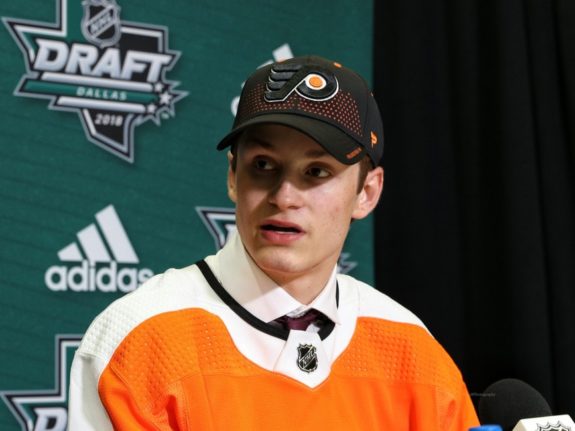
9) Nick Suzuki, Montreal Canadiens
PROJECTED ROLE: 2RW
ANALYSIS: Suzuki, the 13th overall pick from 2017, was a preseason standout for Montreal — punctuating his performance with an overtime winner to solidify his spot in the top six. He’ll need to carry that momentum over to the regular season to stay there, but Suzuki has set himself up for a chance at the Calder if he’s flanking Max Domi and Jonathan Drouin or however that top six shakes out. Suzuki can also play centre, so that versatility could keep him in the lineup and in the NHL as long as he continues to make forward progress.
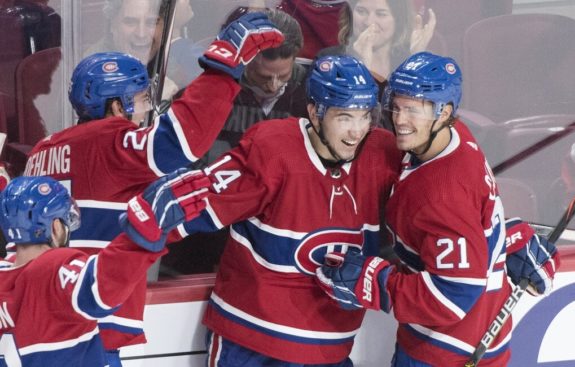
8) Victor Olofsson, Buffalo Sabres
PROJECTED ROLE: 1RW
ANALYSIS: Olofsson, an overachieving seventh-rounder from 2014, is an older rookie at 24 but could be poised to fill the net at the NHL level after scoring 30 goals in the AHL during his North American debut last season. Olofsson has a wicked shot, which he has shown Ralph Krueger repeatedly in the preseason. In doing so, Olofsson has earned praise from the Sabres’ new coach and the opportunity to start on Buffalo’s top line with Jack Eichel and Jeff Skinner. If he can stick there, Olofsson has to be considered a sleeper for the Calder.
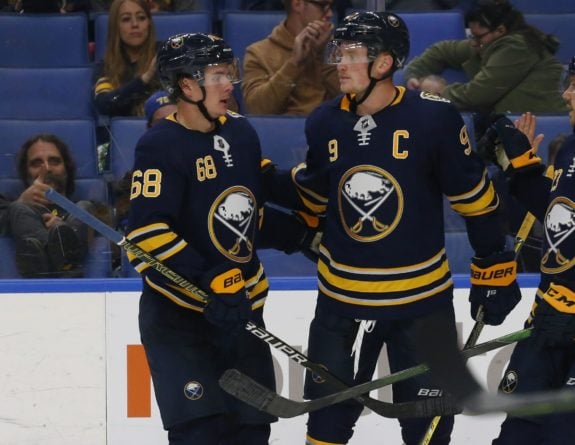
7) Alex Nylander, Chicago Blackhawks
PROJECTED ROLE: 1LW
ANALYSIS: Nylander, the eighth overall pick from 2016, wasn’t panning out in Buffalo but is now getting the opportunity of a lifetime in Chicago — starting on the top line alongside Jonathan Toews and Patrick Kane. It doesn’t get any better than that and deployment often dictates the Calder race, providing it results in production. Going back to his draft year, many felt Alex had the potential to be the better Nylander brother — better than William in Toronto — and it appears the Blackhawks are going to give him every opportunity to prove it. Nylander is only 21, so it was always too early to label him a bust, and suddenly he’s in a position to break out in a big way.
6) Adam Fox, New York Rangers
PROJECTED ROLE: 3RD, PP
ANALYSIS: Fox, a third-round pick from 2016, forced his way onto the Rangers through trades from Calgary and Carolina and could now force his way onto their power play. He’s behind Jacob Trouba and Anthony DeAngelo on the right side and both of them are power-play types too. But David Quinn knows Fox from his NCAA days and will try to deploy him in positions to succeed, which should include power-play time. Fox has the talent to capitalize on those opportunities and perhaps force his way into the Calder conversation.
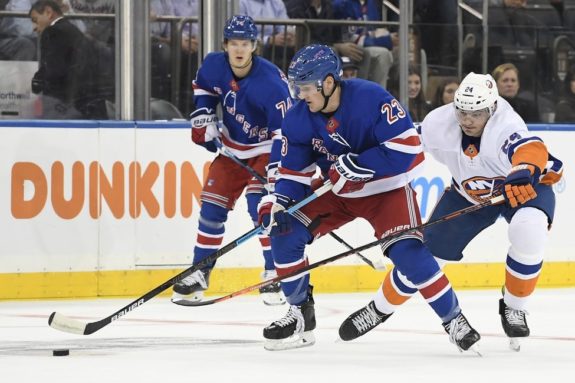
5) Quinn Hughes, Vancouver Canucks
PROJECTED ROLE: 2LD, PP
ANALYSIS: The elder Hughes brother, the seventh overall pick from 2018, is arguably the most offensively gifted blueliner on Vancouver’s roster as a rookie. That could mean manning the top power-play unit with Elias Pettersson and Brock Boeser from Day 1, along with lots of offensive-zone starts at even strength. In that case, this Hughes has to be given some Calder consideration.
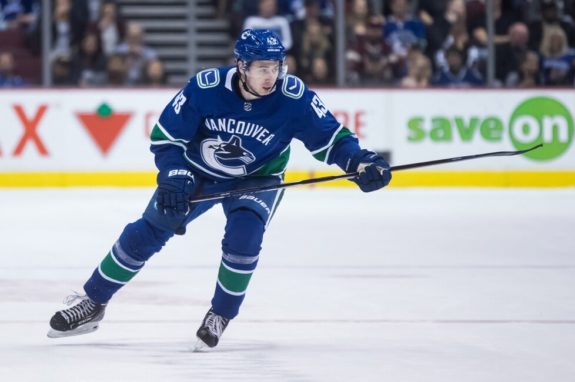
4) Cody Glass, Vegas Golden Knights
PROJECTED ROLE: TBD
ANALYSIS: Glass, the sixth overall pick from 2017, will have to prove he’s NHL ready in the early stages of the regular season. If not for injuries to Cody Eakin and Alex Tuch, Glass may have been starting out in the AHL. Now it looks like he could be centering the top line between Max Pacioretty and Mark Stone — as was the case for Vegas’ preseason finale — but that spot typically belongs to Paul Stastny. When everyone is healthy, it’ll be interesting to see where — and if — Glass fits into the Golden Knights’ lineup. It’s possible he could land on the third line with both Eakin and Tuch — playing either centre or wing. But Glass will need to hit the ground running to stay in the big league and stay in the running for the Calder.
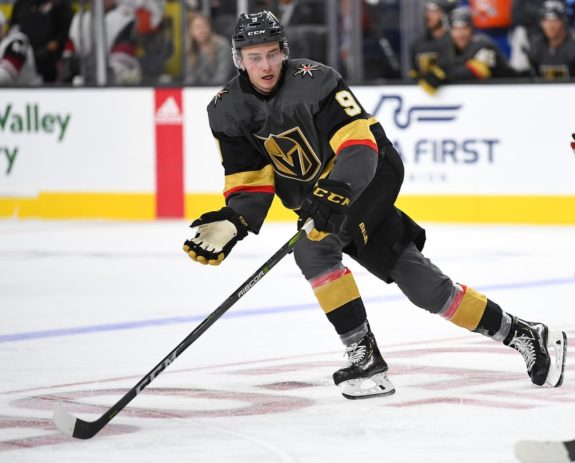
3) Cale Makar, Colorado Avalanche
PROJECTED ROLE: 2RD, PP
ANALYSIS: Makar, the fourth overall pick from 2017, is done dominating the college ranks and ready to take the NHL by storm. There were glimpses of his potential upon joining Colorado for the playoffs, but now Makar will essentially be stepping into Tyson Barrie’s role. Those are obviously big skates to fill, but Makar has massive upside and should be able to make the most of that opportunity, which will include ample power-play time. It’s difficult for defencemen to win the Calder — they need to put up big offensive numbers — but Makar’s combination of talent and opportunity make him a legitimate candidate.
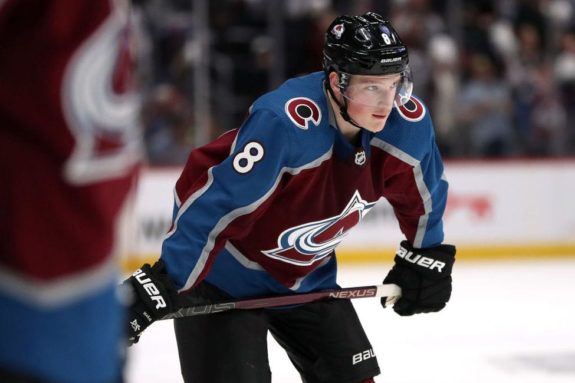
2) Jack Hughes, New Jersey Devils
PROJECTED ROLE: 2C, PP
ANALYSIS: Hughes, the first overall pick in this year’s draft, is certainly one of the frontrunners. He’ll get plenty of offensive opportunity and should be a catalyst for the Devils from the outset, though there could be some growing pains since the NHL game moves way faster than the junior and college opposition that he’s used to. The players are much bigger and stronger too, which could prove challenging for the undersized Hughes, but he’s always been elusive with elite vision and the ability to process at a high level. Hughes should contend for the Calder regardless of his linemates, but his chances of winning the award will go way up if he winds up centering Taylor Hall.
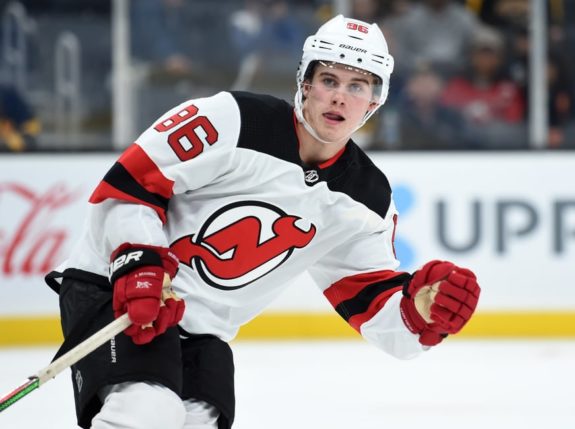
1) Kaapo Kakko, New York Rangers
PROJECTED ROLE: 2RW, PP
ANALYSIS: Kakko, the second overall pick in this year’s draft, is a slight favourite for the Calder because he’s a bit more polished than Jack Hughes from already playing pro in Finland. Hughes may have the more productive career overall, but Kakko might make more of an immediate impact. Kakko is slated to start on the second line with Chris Kreider and Ryan Strome, which isn’t as appealing as the top-line role with Artemi Panarin and Mika Zibanejad. That spot belongs to Pavel Buchnevich for now, but Kakko could overtake him and run away with the Calder.
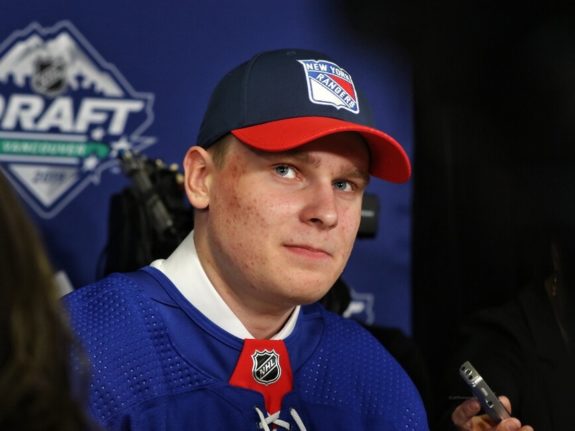
Recapping Calder Candidates
31) Dillon Dube, Calgary Flames
30) Morgan Frost, Philadelphia Flyers
29) Filip Zadina, Detroit Red Wings
28) Vitali Kravtsov, New York Rangers
27) Oliver Wahlstrom, New York Islanders
26) Thatcher Demko, Vancouver Canucks
25) Dante Fabbro, Nashville Predators
24) Jesper Boqvist, New Jersey Devils
23) Emil Bemstrom, Columbus Blue Jackets
22) Dominik Kubalik, Chicago Blackhawks
21) Taro Hirose, Detroit Red Wings
20) Kirby Dach, Chicago Blackhawks
19) Noah Dobson, New York Islanders
18) Barrett Hayton, Arizona Coyotes
17) Max Comtois, Anaheim Ducks
16) Ryan Poehling, Montreal Canadiens
15) Drake Batherson, Ottawa Senators
14) Sam Steel, Anaheim Ducks
13) Alexandre Texier, Columbus Blue Jackets
12) Erik Brannstrom, Ottawa Senators
11) Martin Necas, Carolina Hurricanes
10) Joel Farabee, Philadelphia Flyers
9) Nick Suzuki, Montreal Canadiens
8) Victor Olofsson, Buffalo Sabres
7) Alex Nylander, Chicago Blackhawks
6) Adam Fox, New York Rangers
5) Quinn Hughes, Vancouver Canucks
4) Cody Glass, Vegas Golden Knights
3) Cale Makar, Colorado Avalanche
2) Jack Hughes, New Jersey Devils
1) Kaapo Kakko, New York Rangers
HONOURABLE MENTIONS: Eeli Tolvanen (NSH), Rasmus Sandin (TOR), Ty Smith (NJD), Adam Boqvist (CHI), Denis Gurianov (DAL), Jordan Kyrou (STL), Carl Grundstrom (LAK), Dylan Gambrell (SJS), Mackenzie Blackwood (NJD), Philippe Myers (PHI), Carter Verhaeghe (TBL), Joakim Nygard (EDM), Blake Lizotte (LAK), Jaret Anderson-Dolan (LAK), Owen Tippett (FLA), Jake Bean (CAR), Mario Ferraro (SJS), Nic Hague (VGK), Jimmy Schuldt (VGK), Conor Timmins (COL), Calle Rosen (COL), Joel Persson (EDM), Ethan Bear (EDM), Ville Heinola (WPG), Tobias Bjornfot (LAK), Victor Soderstrom (ARI), Aleksi Heponiemi (FLA), Klim Kostin (STL), Julien Gauthier (CAR), Kristian Vesalainen (WPG), Logan Brown (OTT), Joe Veleno (DET), Nikolai Prokhorkin (LAK), Ilya Mikheyev (TOR), Trevor Moore (TOR), Pavel Francouz (COL), Elvis Merzlikins (CBJ), Cale Fleury (MON), Tucker Poolman (WPG), Libor Hajek (NYR), Danil Yurtaykin (SJS), Lean Bergmann (SJS), Alex Nedeljkovic (CAR), Sam Montembeault (FLA), Adin Hill (ARI), David Gustafsson (WPG), John Marino (PIT), Martin Fehervary (WSH), Timothy Liljegren (TOR), Dmytro Timashov (TOR).